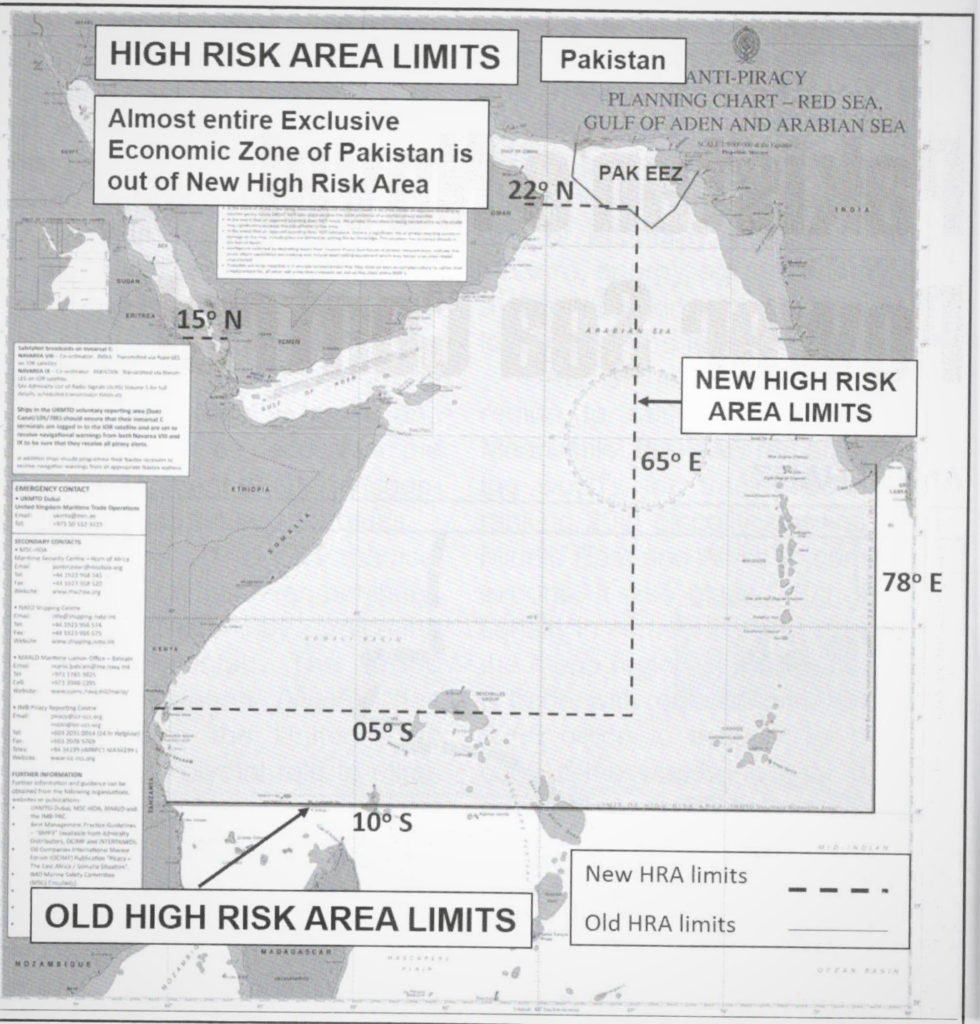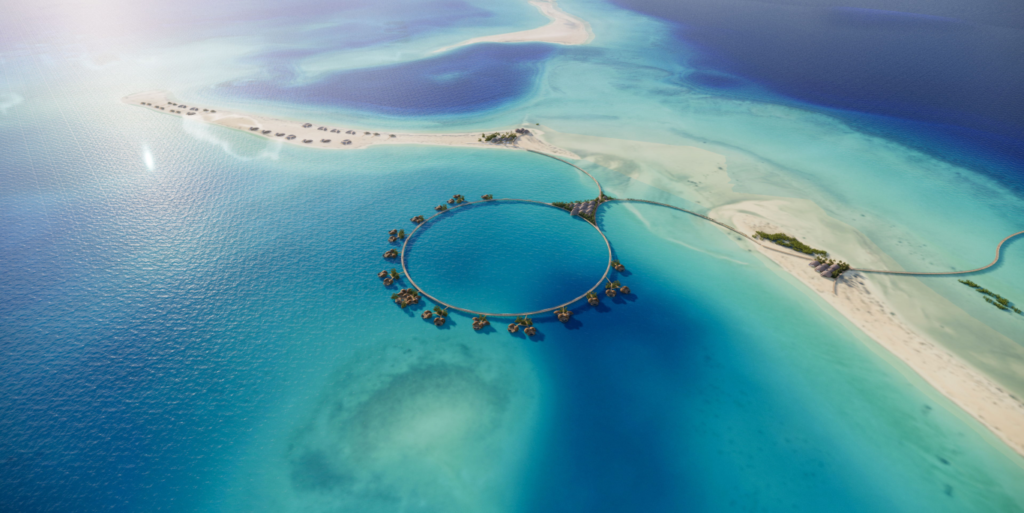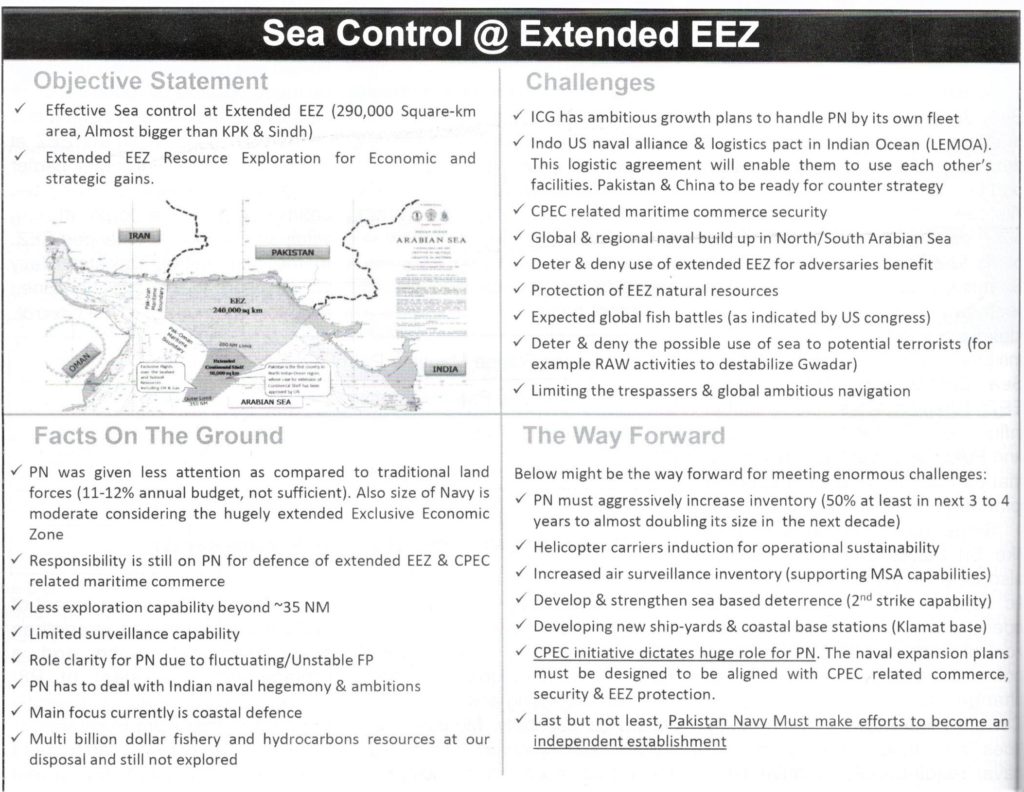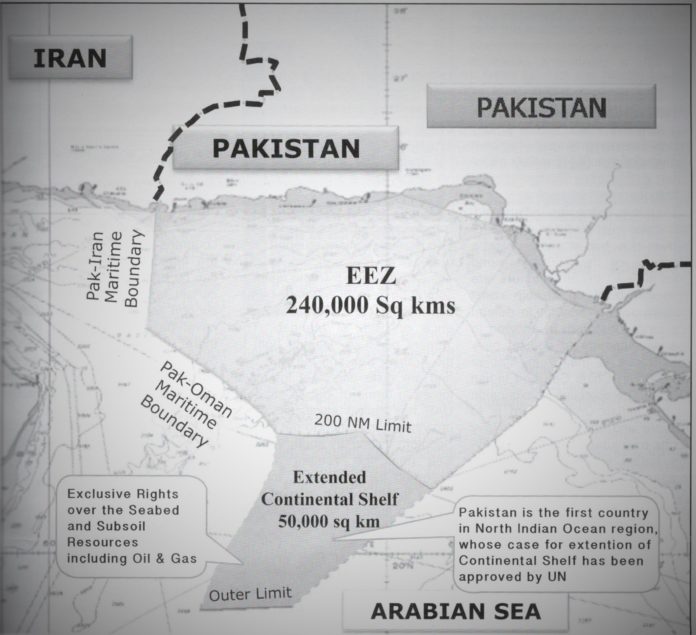As discussed in previous articles on the same subject that current economic and geo political scenario elaborates a huge role for Pakistan navy that has the responsibility to safeguard the economic and security interests of Pakistan in light of CPEC project for maritime commerce, protection and exploration of Pakistan’s Exclusive Economic Zone plus extended continental shelf and influence in dominion of interests. Thus, the rise of a superior and powerful Pakistan navy is the need of the time not only for protecting the ambitious economic plans but also because the region is transforming through a significant paradigm shift specifically in the Indian Ocean and north/south Arabian Sea. The awareness for developing effective naval force is very much there amongst regional nations specifically the Gulf countries and those nations having ambitious adversary plans.
In this scenario, the Indian Navy has been planning for significant growth for her coastal defence because of the 7500 km long coastal line, Indian planners are trying to build up sizable coast guard powerful enough to defend the long coast line. In addition to the development of coastal navy their focus is mainly in Arabian Sea, South China Sea and Indian Ocean. The objective of expansion of the Indian Coast Guard is to counter and check Pakistan Navy on its own strength thereby relieving Indian Navy to maintain its presence/dominance in South Arabian Sea and Bay of Bengal and generally in the Indian Ocean.
Similarly, we observe a gradual buildup of Iranian and Saudi Navies in the north/south Arabian Sea, Persian Gulf and Red Sea area that could result in an additional sensitive point. Both the Saudis and Iranians support their proxies in the ongoing war in Yemen with each trying to maintain control on Yemeni waters, its adjacent Islands and increased influence on Bab el Mandab. The Yemeni ports are located both in the Arabian Sea and the Red Sea and are quite important for naval forces in terms of logistic support. UAE has shown significant naval growth and managed to get hold of Socotora Island in south Arabian Sea near the Yemeni shores. Following the same path, India is trying to get logistic support from Oman to support its maritime missions in regional waters.
We, as Pakistanis, must develop a plan to get hold of some strategic islands in the North/South Arabia Seas, Persian Gulf, Red Sea and Gulf of Aqaba. Most of the countries in this maritime domain are friendly to Pakistan and one can be optimistic Pakistan can get certain favors in terms of logistic support and even leverage to build naval bases in identified Islands there. However, there are as yet no apparent strategic moves from our diplomatic missions and planners in Islamabad. We must be active here as time is passing quickly and we cannot afford further loss. I will elaborate this aspect further down in this article. Moreover, China has recently established a naval base in Djibouti in Babel Mandab for controlling/ monitoring Chinese trade interests through this choke point. The United States navy has already established a base in that country and now with the Chinese naval base, these two major power players are sitting next to each other. Since Djibouti is located on one of the world’s most critical choke points and controlling choke points is one of the main requirements to be a global blue water naval force, hence the Chinese are showing significant expansion in this part of the world for economic and strategic reasons.
Some of the major factors that dramatically shuffled the entire strategic paradigm in the region are emergence of new Indo-USA power bloc in the Indian Ocean and South China Sea, expansion of Chinese military power, emergence of SCO bloc and China led OBOR project. India and USA are clearly on the same page in terms of their plans for curtailing Chinese rising influence and in response China is engaging regional and other countries through huge economic incentives under OBOR vision. In this scenario, the China-Pakistan Economic Corridor (CPEC) is the key project where Chinese have managed to get another Sea extension keeping in mind the situation in the Strait of Malacca.
The million-dollar question here is, are we ready to reap the enormous benefits from CPEC project and what are the deficiencies in our maritime structure that need to be rectified quickly within the next 3 to 4 years. The huge maritime challenge is protecting Pakistan’s Exclusive Economic Zone (EEZ) which is 240,000 Sq. Km, with continental shelf extending a further 50,000 sq. km. Pakistan has fought its case at the UN in recent years and won the case for extension of its continental shelf. The total Sea bed area now sums up to 290,000 sq. kms which is more than the combined area of Sindh and Khyber Pakhtunkhwa (KPK) provinces. Taking into account the existing inventory of Pakistan navy as compared with capability to protect the extended economic zone and other CPEC related maritime challenges, its capability seems to be insufficient to cover the full challenge as per my personal observations.
Pakistan naval and political leadership must come up with an urgent plan on how to protect the nation’s interests in 290,000 square kilometers extended economic zone. The only and effective way to protect this maritime limit is the concept of Sea Control. The term Sea Control is often used in maritime sector and basically this is the concept to ensure establishment of naval superiority in the areas where operations are intended to be conducted. Pakistan’s interests must be well strategized by our naval leadership for an effective Sea Control at Pakistan’s 290,000 square kilometers extended economic zone. This huge economic zone is blessed with fishery, hydrocarbons and other seabed resources. If Pakistan navy somehow lacks in the Sea Control capability within its extended EEZ, other trespassing adversaries will find it easy to loot our national wealth.

It has been noticed that unknown fishing trawlers with sophisticated machinery have been trespassing in our area of jurisdiction in the Arabian Sea engaged in illegal fishing since ages and we are mostly unable to stop this illegal activity. The safeguarding of our fishery resources is of utmost importance for Pakistan because enormous employment opportunities can be generated with development and advancement of the fishing industry. If Pakistan cannot monitor its outer boundaries of EEZ jurisdiction, this illegal fishing will continue along with other threats that could emerge from inter-state territorial disputes, political instability, piracy, dumping of toxic waste, human smuggling, drugs/ arms smuggling and transnational crimes including maritime terrorism such as the blowing up of a fishing boat by Indian Coast Guard not too long ago. Trespassers in our area of maritime Jurisdiction must be dealt with strictly but this can be only possible if the Pakistan Navy is able to maintain acceptable level of Sea Control over Pakistan’s extended Economic zone.
Moreover, in addition to the naval Sea Control over the extended Exclusive Economic Zone and in order to be taken seriously, this should be followed by robust military capacity, pursuit of objectives through psychological measures, media warfare and legal means to prevent adversaries from undermining Pakistan’s national interests in our maritime jurisdiction. Although some initial steps have been taken and Pakistan is enforcing her legal rights by stipulating foreign aircrafts to file flight plans before transiting over the EEZ along with formation of Maritime security agency (MSA), still lot of work needs to be done in order to maintain effective naval presence at outer boundaries of our maritime jurisdiction.
We have to keep in mind that protection of our extended EEZ and CPEC related commerce is the Pakistan Navy’s ultimate responsibility within its maritime area of Jurisdiction (EEZ). CPEC is so important for China that it became the flagship project for OBOR vision. In addition, we see another reality in this scenario, the huge strategic pressure that the Chinese are facing in the South China Sea from Indo-US naval alliance, is the prime factor for development of additional ports through Pakistan and Myanmar to get easy access to Arabian Sea and Bay of Bengal. This way, Pakistan is greatly helping the Chinese to enable it become an economic and world power. In the same way, Pakistan helped the US to become a sole super power by standing against USSR in Afghanistan, USSR disintegrated consequently. It can thus be said that Pakistan has a unique geographic status to make or break the stature of the super powers of late.
The impact of getting access to the Arabian Sea via Gwadar is many times more important than any other sea port that China is investing on. Having said that, if China is investing immensely in the CPEC domain and helping Pakistan at the UN level by blocking Indian resolutions backed by US against Pakistan, it is solely under the reciprocity rule and again, Pakistan is also helping China so that she could become an economic and world power. Pakistan will be better-off with Chinese and Russian economic and strategic collaboration rather than any western fake alliances. Pakistan respects Chinese investment for CPEC but care must be taken that Pakistan also benefits from the huge economic outcome of this project without compromising its sovereignty.
While stressing on the importance of a strong Pakistani naval force for effective Sea control, I am obliged to mention that if Pakistan will not be able save its extended EEZ and CPEC related trade, China will occupy this space because China will have to ensure CPEC related commerce through Gwadar at any cost due to its enormous importance. All CPEC related and other maritime commerce from Pakistani ports must be under Pakistan’s control, this is the major reason for our leadership to invest massively on the Pakistan Navy. This is the hard fact we have to elaborate to the political and military establishment on why we need strong navy. I am convinced that sufficient resources have been allocated to land based defence and a trustable deterrence is available to block enemy intentions, but this joint threat is very well present in the maritime domain.

Leveraging Saudi Alliance for Sea Control
The Islamic Military Counter Terrorism Coalition (IMTCT) is an “https://en.wikipedia.org/wiki/Intergovernmental organization” inter government alliance meant to Counter-terrorism activities in the Muslim world, specifically military action against ISIL ISIS. The alliance has a joint operations center in Riyadh Saudi Arabia. On 6 January, 2017, Pakistan’s former Chief of Army Staff, General (Retd) Raheel Sharif was named the IMA’s first Commander-in-Chief. Pakistan can leverage this stature by asking for naval logistic support from countries that are part of this alliance. For instance, UAE is utilizing Socotora Island as its naval logistic station and Pakistan can do the same. Only aggressive and effective diplomacy along with strong resolve from our political and military establishment is required.
I do not know if anyone from our hierarchy has discussed this with friendly countries but if such naval logistic agreements are being arranged, the Pakistan Navy could use islands in the Arabian Sea such as Socotora and its adjacent smaller Islands like Darsah, Kilmia and Samhah, Red Sea Islands under Saudi control, Gulf Oman Islands like Almassirah, Khuriya Muriya Islands like AlQibliah, Alhallaniyah and Alsawda, Bosas in Somalia and port Sudan in Red Sea. Some islands within Pakistani maritime jurisdiction can also be developed for naval logistic support like Astola and Charna islands. We can also aggressively leverage our friendship with Turkey that has plans to establish military bases in Somalia, Qatar and in some other regional countries. We can get logistic support from those Turkish military stations in order to fulfill our Sea Control vision at extended EEZ. Turkey has also great deal of influence in the Mediterranean Sea and Pakistan should get involved in that part of the world for supporting joint operations.
Some other countries in IOR like Sri Lanka and Maldives can also help Pakistan Navy for logistic support to maintain maritime operations and have effective sea control over our EEZ. One more point to elaborate here is to change the defensive mindset. Currently Pakistan’s foreign policy does not dictate and guide our naval requirements to have such ambitious and offensive plans but this must be an option always on the table in front of our planners. We have an example during the 1965 war when Indian radar station at Dwarka was neutralized. This was an offensive operation, so if it could be done in those days, why not be ready to exercise it again if required to do so for the protection of our interests. I am a feeling we will have enough opportunities to exercise offensive strategy in safeguarding CPEC related commerce and protecting other maritime interests in near or distant future.
Indian Ambitious Advancements/Emerging Concerns
The Indians have made some recent advancement in their strategy after having the joint strategic pact with US navy. The Indian coast guard is going to be a huge force in the years to come and a massive budget has been allocated for this purpose. On the other hand, Pakistan’s naval budget is still at a very moderate level and needs to be increased sufficiently on urgent basis.
The Indians seem to have a few edges on our navy due to some recent procurement from the United States like the induction of P8I surveillance aircraft having around 14 hours endurance capability. Moreover, the Indians also procured nuclear sub marines which will help maintain their long-term operational capabilities. On another front, Indians have tested their Brahamos supersonic missile (Mach #2) with around 100 km range. These should be some areas of concern for our establishment.
The Way Forward for Sea Control
Defence can be eased by stationing Pakistan naval troops on distant islands like Socotora, Red Sea and other friendly nation islands to facilitate the Sea Control vision. Again, stationing of our troops on other Islands can only be done if aggressive diplomatic efforts are in place by our political and military planners along with expert diplomats. Currently, we cannot achieve complete sea control over the entire EEZ since it is not possible due to limited sea platforms/ships but it can be made possible by round the clock air surveillance and deployment of 3–5 surface ships within the EEZ at any given time. Helicopter carrier can also provide limited/moving sea control around the force moving within or outside the extended EEZ. In the near future, Pakistan Navy would need the under mentioned inventory for moderate Sea Control.
In addition, the procurement of nuclear submarines to strengthen sea-based deterrence and a replacement equivalent of P8I surveillance air craft is urgently required (either from European or Russian Market). We also need naval repair facilities for urgent and effective time elapsed repairs during emergency periods. A repair development center (RDC) with state-of-the-art equipment and trained technical staff is of utmost importance for advancement of our naval force. I will elaborate details of such RDC later.
| -8-10 long range maritime patrol Aircrafts (LRMPAs). |
| -10-15 maritime patrol Aircrafts (MPAs) |
| -20-25 Surface Ships. |
| -15-20 fast Attack Missile Crafts. |
| -25-30 Helicopters |
| -02-03 Helicopter carriers (an be built within KSEW) |
Concluding Remarks
In view of the enormous challenges that Pakistan Navy will have to face in the coming future, I am obliged to stress that there should be a very strong resolve by the military and civilian leadership for strengthening Pakistan Navy so that CPEC and other maritime related interests like Sea Control are protected. If our leadership fails to understand or fulfill PN requirements we will lose the space and “others” will take charge of maritime trade protection. We must never allow that to happen. While we already know that CPEC dictates a huge role for Pakistan Navy, I am of the view that Pakistan Navy should make efforts to become an independent establishment like in many other countries with global or regional naval stature. Lastly, even though CPEC is a vital project for the nation’s economy and will benefit both Pakistan and China, we must stress Pakistan as the connecting corridor/Hub for regional countries on all forums. CPEC is just one example of such connectivity potential. Another connecting corridor might be Turkey-Iran-Pakistan economic corridor (TIPEC) and is already on ground via RCD highway between Iran, Turkey and Pakistan. It just needs to be upgraded with required infrastructure and can be further extended to central Asia and Caucasus countries. Afghanistan is already benefiting from the transit trade agreement. The overall facts, challenges and the way forward for Sea Control is summarized in a template below.





